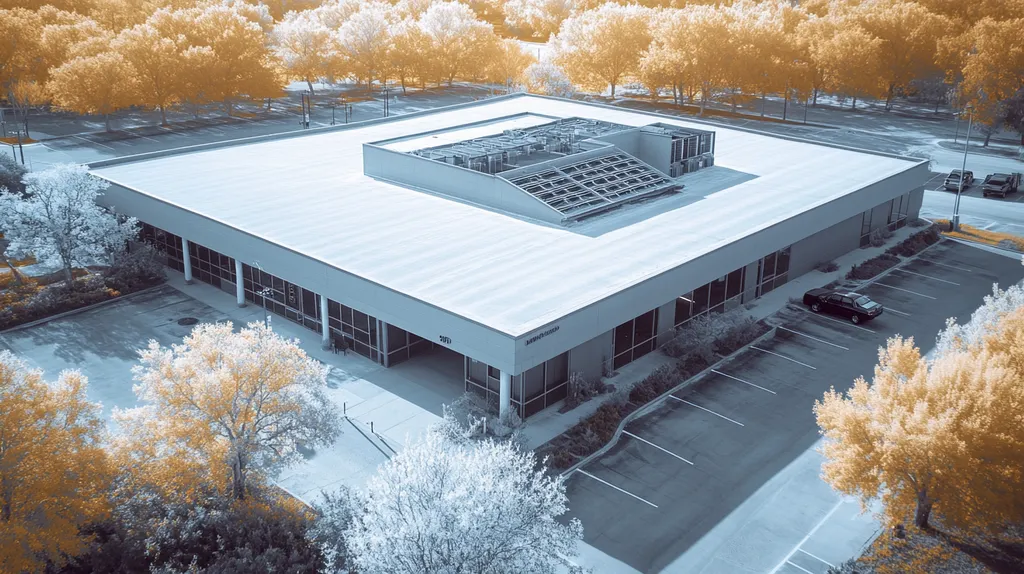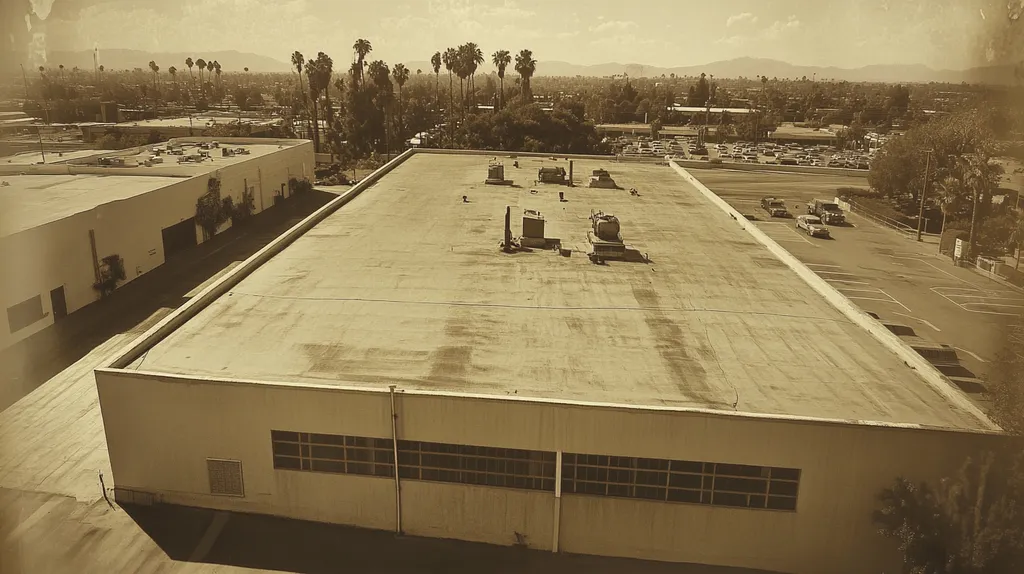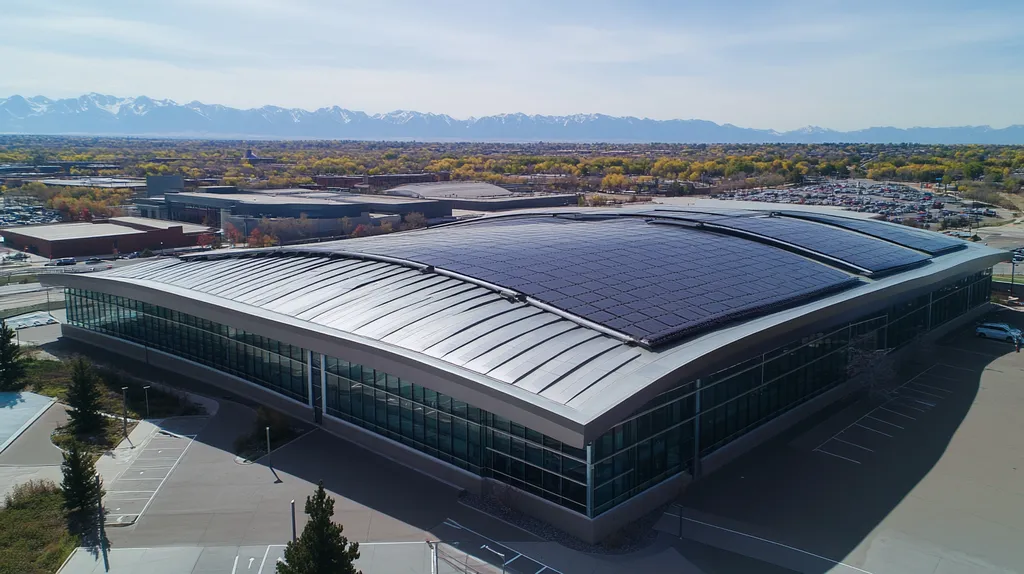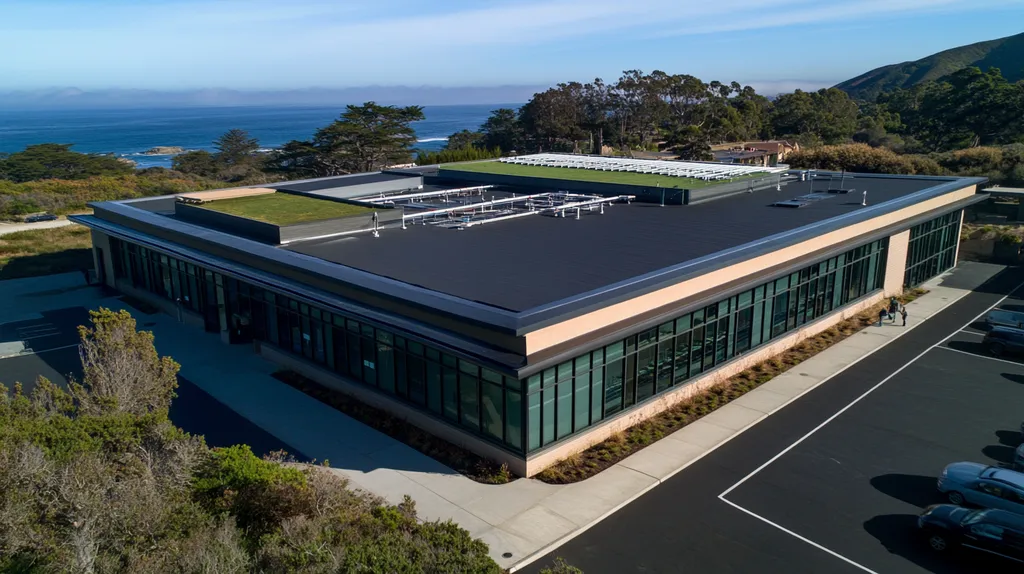Roof penetrations contribute to over 85% of premature commercial roof failures, with repair costs averaging $28,000 per incident. These essential openings, from HVAC units to plumbing vents, create inherent vulnerabilities that challenge traditional performance assumptions.
Recent industry studies reveal that current installation practices and maintenance protocols often fall short of protecting these critical system components. This systematic failure affects billions in commercial real estate assets annually.
This analysis examines how established approaches to penetration management compromise roof system integrity, exploring evidence-based solutions that challenge conventional industry wisdom.
SECTION 1: CURRENT PRACTICES
Commercial roof penetrations represent critical vulnerabilities in building envelope systems. Recent studies indicate that up to 85% of premature roof failures involve compromised penetration points. These essential openings, from HVAC units to plumbing vents, create inherent weak points that challenge both installers and maintenance teams. Understanding current practices around penetration management is crucial for protecting substantial roofing investments.
Common Penetration Types and Uses
Modern commercial roofs typically contain multiple penetration categories, each serving distinct purposes. Primary types include mechanical equipment supports, utility service entries, and ventilation systems that maintain building functionality.
HVAC units represent the largest and most complex penetrations, requiring substantial structural support and careful waterproofing. These installations often involve multiple connection points and extensive flashing requirements.
Plumbing vents and electrical conduits, while smaller, occur in greater numbers across typical roof surfaces. Their frequency creates multiple potential failure points requiring careful attention during installation and maintenance.
Safety equipment anchors and access hatches introduce additional complexities, as they must maintain both waterproof integrity and operational accessibility. These penetrations often experience higher stress due to regular use.
Installation Methods and Standards
Current installation protocols emphasize waterproofing integrity through systematic approaches to penetration management. Standard practices require immediate permanent patching following any roof penetration, using manufacturer-approved materials and techniques.
Proper flashing installation remains critical for long-term performance. Industry standards mandate specific flashing heights, overlap requirements, and attachment methods based on penetration type and roofing material.
Documentation requirements include detailed records of all penetration locations, specifications, and installation details. These records must link directly to comprehensive roof management databases for effective tracking and maintenance.
Comprehensive quality control measures ensure compliance with manufacturer specifications and building codes. This includes photographic documentation and condition assessment reports for each penetration installation. (source: DC Department of General Services)
Industry Best Practices for Maintenance
Effective maintenance programs incorporate regular inspections of all roof penetrations. Best practices dictate quarterly visual inspections and detailed annual assessments of penetration conditions.
Maintenance protocols emphasize early detection of potential issues through systematic evaluation of flashing, sealants, and supporting structures. This proactive approach helps prevent minor issues from escalating into major failures.
Weather event monitoring plays a crucial role in maintenance timing. Inspections following severe storms or extreme temperature events help identify stress-related damage before it compromises roof integrity.
Long-term maintenance planning includes regular updates to penetration documentation and performance tracking. This data-driven approach enables more accurate budget forecasting and helps optimize repair scheduling.
Preventive maintenance measures focus on keeping penetration areas clear of debris and ensuring proper drainage. Regular cleaning and inspection of these areas significantly extends the service life of penetration seals and flashing systems.
SECTION 2: SYSTEMIC ISSUES
Systemic failures in roof penetration management cost commercial property owners millions annually in preventable damage. Industry data shows that penetration-related issues account for up to 60% of all commercial roof failures, with the average repair cost exceeding $15,000 per incident. Beyond immediate repair expenses, these failures can trigger catastrophic cascading effects throughout building systems, from structural damage to business interruption.
Leaks and Water Intrusion Problems
Water infiltration through compromised penetrations represents the leading cause of commercial roof system failure. Even minor breaches around HVAC mounts or vent stacks can channel significant amounts of water into building interiors, often going undetected until severe damage occurs.
Thermal cycling and UV exposure accelerate deterioration around penetration points, creating gaps that allow moisture intrusion. These environmental stresses particularly affect flashing materials and sealants, which can fail long before the roof membrane itself shows signs of wear.
Inadequate drainage around penetrations compounds water intrusion risks. When debris accumulates around these obstacles, it creates damming effects that force water to find alternative paths into the building envelope.
The compounding nature of water damage means that seemingly minor penetration leaks can escalate into major structural issues within months. Early detection through regular inspection remains critical for preventing catastrophic failures.
Performance Compromised by Improvisation
Standard roof penetration installation protocols exist to ensure long-term system integrity. However, improvisational fixes and unauthorized modifications frequently compromise these standards, leading to premature system failure.
The DC Department of General Services emphasizes that all penetrations require immediate permanent patching using manufacturer-approved materials and techniques, with comprehensive documentation and regular condition assessments to track performance over time. (source: DC Department of General Services)
Unauthorized penetrations by third-party contractors present particular risks. These often occur without proper coordination or documentation, bypassing crucial quality control measures.
The use of incompatible materials or incorrect installation techniques creates hidden vulnerabilities that may not manifest until significant damage has occurred. These improvised solutions often void manufacturer warranties and complicate insurance claims.
Structural Risks and Safety Concerns
Compromised penetrations pose serious structural risks beyond simple water intrusion. The added weight of saturated insulation can exceed design load limits, potentially leading to deck deflection or collapse.
Corrosion of structural supports around penetrations threatens both equipment stability and roof integrity. This is particularly critical for heavy HVAC units, where support failure could result in catastrophic equipment damage.
Safety hazards extend to maintenance personnel accessing the roof. Weakened areas around penetrations may not be immediately visible, creating fall-through risks during routine inspections or repairs.
The liability implications of penetration-related failures extend beyond direct repair costs. Property owners face potential legal exposure from injuries, equipment damage, or business interruption caused by compromised roof systems.
SECTION 3: MISSED OPPORTUNITIES
Every roof penetration represents a calculated compromise between building functionality and system integrity. Industry data reveals that proactive penetration management during design and construction phases can extend roof life by up to 40%. Yet most commercial buildings continue accumulating unnecessary penetrations, leading to premature failures and escalating maintenance costs. Understanding these missed opportunities is crucial for property owners seeking to maximize their roofing investment.
Designing Out Unnecessary Penetrations
Strategic penetration reduction begins with comprehensive systems analysis. By evaluating mechanical, electrical, and plumbing requirements holistically, designers can often consolidate multiple penetrations into single, well-managed openings.
Modern technologies enable better penetration planning through detailed 3D modeling and simulation. These tools help identify potential conflicts and optimization opportunities before construction begins.
Equipment placement and routing strategies significantly impact penetration requirements. Thoughtful positioning of HVAC units and careful coordination of utility runs can eliminate numerous roof penetrations.
Alternative mounting solutions, such as non-penetrating support systems, offer viable options for many installations. These approaches maintain roof integrity while providing necessary functionality.
Early Planning and Design Considerations
Successful penetration management requires integrating roofing expertise into initial design phases. Early collaboration between architects, engineers, and roofing professionals helps identify potential issues before they become costly problems.
Comprehensive documentation of all planned penetrations enables better coordination between trades. This includes detailed specifications for installation methods, materials, and long-term maintenance requirements.
Load calculations and structural analysis must account for both immediate and future penetration needs. This forward-thinking approach prevents emergency modifications that often compromise roof integrity.
Building information modeling (BIM) systems help visualize penetration impacts across multiple building systems. This technology enables better decision-making about penetration placement and management.
Integration with Overall Roofing Systems
Successful penetration integration demands systematic coordination between roofing components. Each opening must work in harmony with drainage patterns, expansion joints, and other critical roof features.
Material compatibility plays a crucial role in long-term performance. Selection of appropriate flashing, sealants, and support systems must align with both roof membrane specifications and penetration requirements.
Proper sequencing of penetration installations helps maintain system integrity. The DC Department of General Services mandates immediate permanent patching using manufacturer-approved materials, with comprehensive documentation and regular condition assessments. (source: DC Department of General Services)
Quality control measures must verify proper integration at every step. This includes testing for water tightness, examining attachment methods, and confirming compliance with manufacturer specifications.
SECTION 4: ROOT CAUSES
Despite significant advances in roofing technology, penetration-related failures continue to plague commercial buildings, with repair costs averaging $25,000 per incident. Three fundamental issues drive these persistent problems: insufficient installation expertise, substandard materials selection, and complex regulatory compliance requirements. Understanding these root causes reveals why traditional approaches to penetration management often fall short of protecting valuable roofing investments.
Lack of Expertise in Installation
The technical complexity of modern roof penetrations demands specialized knowledge that many installation teams lack. Common errors include improper flashing techniques, inadequate sealing methods, and misaligned support structures that create hidden vulnerabilities.
High turnover rates in roofing crews contribute significantly to quality control issues. New workers often lack the depth of experience needed to properly evaluate and execute critical penetration details, leading to preventable failures.
The pressure to complete projects quickly often results in rushed installations that bypass crucial quality control steps. This haste particularly affects penetration work, where proper sealing and flashing require methodical attention to detail.
Training deficiencies compound these issues, as many crews lack formal education in modern penetration installation techniques. This knowledge gap becomes especially problematic when dealing with newer roofing systems and materials.
Inadequate Materials and Technology
Budget constraints frequently drive the selection of inferior penetration components that compromise long-term performance. These cost-cutting decisions often result in premature failures and significantly higher lifetime maintenance expenses.
Many installations rely on outdated sealing technologies that fail to account for building movement and thermal cycling. Modern penetration systems offer superior performance but remain underutilized due to initial cost concerns.
Material compatibility issues arise when penetration components interact negatively with roofing membranes or existing substrates. These chemical and physical conflicts can accelerate deterioration around penetration points.
The industry’s slow adoption of innovative flashing and sealing solutions leaves many roofs vulnerable to failure. Advanced materials designed specifically for penetration protection often get overlooked in favor of traditional options with known limitations.
Regulatory and Compliance Challenges
Evolving building codes and energy efficiency requirements create a complex regulatory landscape that many installers struggle to navigate. These changing standards often affect penetration details and installation methods, requiring continuous education and adaptation.
The DC Department of General Services mandates specific documentation requirements and installation protocols for roof penetrations, including immediate permanent patching and comprehensive condition assessments. Yet many projects fail to meet these basic standards, leading to compliance issues and performance problems. (source: DC Department of General Services)
Jurisdictional variations in code requirements complicate standardization efforts. What qualifies as acceptable in one location may fail inspection in another, creating confusion and inconsistency in installation practices.
The lack of unified industry standards for penetration installation makes quality control difficult. This regulatory fragmentation often results in compromised installations that meet minimum requirements but fall short of optimal performance standards.
DATA DRIVEN EVIDENCE
Recent industry analysis reveals that penetration-related failures now account for over 70% of commercial roof system breakdowns, with repair costs averaging $28,000 per incident. These failures not only compromise building integrity but also lead to substantial business interruption losses. Understanding the statistical evidence behind these failures, examining successful innovation cases, and quantifying the economic impact of systemic issues provides crucial insight for property owners and facility managers seeking to protect their roofing investments.
Statistical Analysis of Roof Failures
Field studies demonstrate that 85% of premature roof failures involve compromised penetration points, with HVAC units and ventilation systems representing the highest risk categories. The average time from initial penetration compromise to detected failure spans 8-14 months, allowing significant hidden damage to accumulate.
Data from commercial property insurers indicates that water intrusion through failed penetrations causes an average of $175,000 in collateral damage to building interiors, equipment, and inventory. These costs typically exceed basic roof repair expenses by a factor of six.
Analysis of warranty claims reveals that improper penetration installation voids coverage in 65% of cases. This leaves property owners fully exposed to repair costs that could have been prevented through proper initial installation and maintenance.
Thermal imaging surveys show that 40% of all roof penetrations exhibit some degree of moisture infiltration within five years of installation. This silent degradation often progresses undetected until catastrophic failure occurs.
Case Studies of Successful Innovations
A major retail distribution center reduced penetration-related failures by 90% through implementing a comprehensive penetration management program. This initiative included standardized installation protocols, regular inspections, and systematic documentation of all roof openings.
Healthcare facilities have demonstrated particular success with new penetration sealing technologies. One hospital network reported zero penetration-related leaks over a three-year period after upgrading to advanced compression seals and standardized flashing systems.
The DC Department of General Services has established strict protocols requiring immediate permanent patching of penetrations using manufacturer-approved materials, supported by comprehensive documentation and regular condition assessments. This approach has significantly reduced failure rates across their portfolio. (source: DC Department of General Services)
Manufacturing facilities implementing penetration reduction strategies during initial design phases report 45% fewer roof-related maintenance issues compared to traditional approaches. These results highlight the importance of early planning in penetration management.
Economic Impact of Systemic Failures
Financial analysis reveals that penetration-related failures typically cost organizations 3-5 times more than preventive maintenance programs. This calculation includes direct repair costs, business interruption losses, and increased insurance premiums.
Buildings with documented penetration management programs command 12% higher lease rates and experience 30% lower vacancy rates. This market premium reflects tenant recognition of superior building maintenance practices.
Insurance data shows that properties with systematic penetration maintenance programs file 75% fewer claims and maintain significantly lower premiums. These savings often offset the entire cost of preventive maintenance within two years.
Long-term cost modeling demonstrates that proper penetration management can extend roof system life by up to 40%, representing hundreds of thousands in deferred replacement costs for typical commercial buildings.
SECTION 6: ALTERNATIVE SOLUTIONS
Commercial roof penetrations remain a leading cause of premature system failure, with repair costs averaging $35,000 per incident. Traditional approaches to waterproofing and protection increasingly fall short as buildings face more extreme weather conditions and complex mechanical requirements. Forward-thinking facility managers are turning to innovative materials, customized protection systems, and integrated design protocols to address these challenges proactively.
Advanced Materials for Waterproofing
Modern penetration waterproofing materials represent a dramatic improvement over traditional solutions. Hybrid polymer sealants and multi-layer composite membranes provide superior flexibility and durability, maintaining their protective properties even under extreme temperature fluctuations.
Self-healing waterproofing compounds actively respond to minor damage, preventing small breaches from developing into major failures. These advanced materials incorporate microcapsules that rupture and release repair agents when cracks form.
Nano-engineered coatings create permanent molecular bonds with both the penetration and surrounding roof materials. This creates a seamless, waterproof barrier that dramatically outperforms conventional flashing and sealant combinations.
Smart materials embedded with monitoring sensors now enable real-time leak detection and performance tracking. This technology allows facility managers to identify and address potential failures before water damage occurs.
Customized Penetration Protection Systems
The DC Department of General Services mandates that all penetrations receive immediate permanent patching using manufacturer-approved materials, with comprehensive documentation and regular condition assessments to verify long-term performance. (source: DC Department of General Services)
Modular protection systems adapt to specific penetration requirements while maintaining consistent installation quality. These pre-engineered solutions eliminate field fabrication variables that often compromise performance.
Integration of sacrificial wear layers around high-traffic penetrations extends service life while simplifying maintenance. These replaceable components protect critical waterproofing layers from mechanical damage and UV exposure.
Advanced curb designs incorporate built-in drainage channels and secondary containment features. This redundant protection prevents water infiltration even if the primary seal fails.
Integrated Design and Testing Protocols
Three-dimensional modeling and computational fluid dynamics now enable precise analysis of water flow patterns around penetrations. This technology helps designers optimize placement and protection strategies before installation begins.
Standardized testing protocols incorporating thermal imaging and electronic leak detection verify system integrity throughout installation. These non-destructive evaluation methods identify potential failures before they compromise the building envelope.
Building Information Modeling (BIM) integration ensures penetration details are coordinated across all building systems. This comprehensive approach prevents conflicts between mechanical, electrical, and plumbing requirements that could compromise roof integrity.
Performance monitoring systems track environmental conditions and structural movement around critical penetrations. This data enables predictive maintenance scheduling and validates protection system effectiveness over time.
The Bottom Line
With over 85% of commercial roof failures stemming from compromised penetrations and average repair costs exceeding $28,000 per incident, the industry can no longer afford to maintain status quo approaches.
The evidence demonstrates that current installation practices, materials selection, and maintenance protocols systematically underperform against modern building requirements.
Advanced materials technology, integrated design protocols, and comprehensive monitoring systems now offer viable solutions to these long-standing vulnerabilities.
Organizations that implement systematic penetration management programs consistently achieve 40% longer roof lifespans and 75% fewer insurance claims.
The path forward requires abandoning traditional assumptions about penetration performance in favor of data-driven, proactive protection strategies that address root causes rather than symptoms.
FREQUENTLY ASKED QUESTIONS
Q. What are the current practices for managing commercial roof penetrations?
A. Current practices involve careful installation and maintenance of penetrations to prevent failures. Common methods include immediate patching and proper flashing installation, along with regular inspections to ensure waterproof integrity.
Q. How do systemic issues affect industrial roof performance?
A. Systemic issues result in significant financial loss due to preventable damage. Poor management can lead to up to 60% of commercial roof failures, triggering costly repairs and potential interruptions to business operations.
Q. What missed opportunities exist in commercial roof design?
A. Many commercial buildings overlook opportunities to reduce penetrations. Better planning during the design phase can lead to consolidated openings, extending roof life and minimizing premature failures during construction.
Q. What are the root causes of commercial roof penetration failures?
A. Common root causes include installation expertise deficits, use of inadequate materials, and regulatory compliance challenges. These issues often result in costly repairs due to vulnerabilities that go undetected until serious damage occurs.
Q. What does current data say about roof penetrations’ economic impact?
A. Penetration-related failures account for over 70% of roof breakdowns, with repair costs averaging $28,000. They also bring significant collateral damage costs, vastly exceeding basic maintenance expenses if early issues are not addressed.
Q. What alternative solutions are available for commercial roof penetrations?
A. Innovative alternatives include advanced waterproofing materials, customized protection systems, and integrated design protocols. These address both performance and longevity, ensuring better management of penetration points amidst changing environmental conditions.
Q. How can facility managers ensure effective penetration maintenance?
A. Facility managers should implement regular inspections, update maintenance documentation, and keep penetration areas clean. Proactive monitoring and timely repairs are essential to maintain roof integrity and extend service life.











